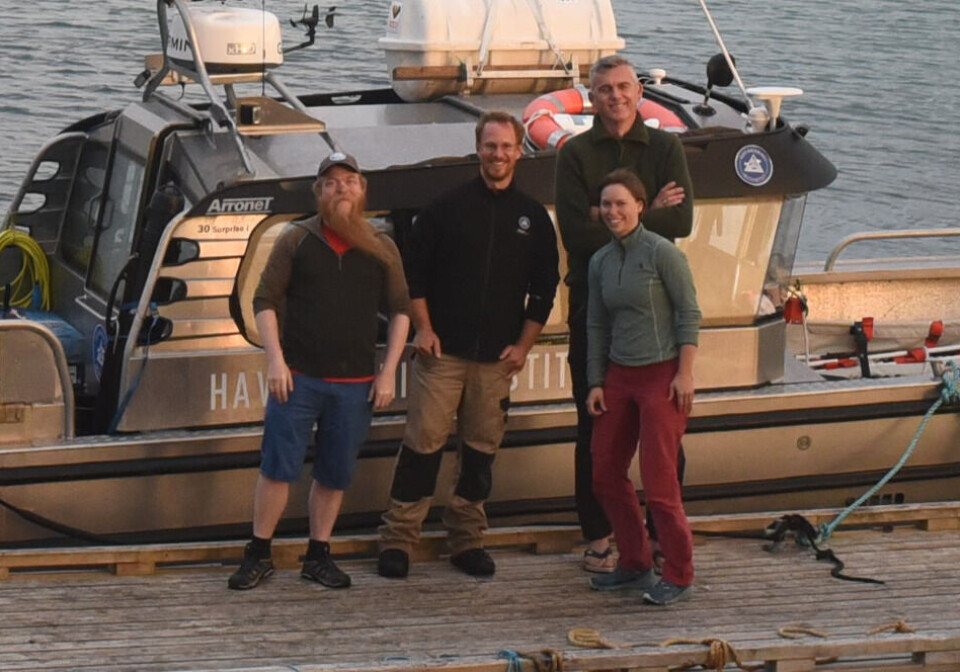THIS ARTICLE/PRESS RELEASE IS PAID FOR AND PRESENTED BY the Institute of Marine Research - read more
Satellite tagging 8-metre sharks
The researchers were able to tag three basking sharks in a single weekend. In one year’s time we will be able to learn more about this giant shark in Norwegian waters.
A tagging team from the Institute of Marine Research (IMR) has spent the past week in the waters off the Lofoten and Vesterålen islands looking for basking sharks – the second biggest fish species in the world. The aim is to satellite-tag the giant sharks to enable researchers to learn more about their movements.
After an unsuccessful week, the researchers finally hit the jackpot last weekend and were able to tag no fewer than three basking sharks. They will spend a few more days in the area hoping to tag even more sharks.
“It’s crazy. We’re really happy,” enthuses tagging expert and marine researcher Keno Ferter.
How it’s done
First, they need to find the proverbial needle in the haystack: the fin protruding from the water. Next comes the tricky job of tagging the shark, which can grow up to 11 metres long and weigh several tonnes.
“When observing basking sharks, we move slowly and gently up alongside them with the boat. We have to be able get right up to the shark without scaring it, otherwise it’ll dive into the deep and disappear. We use a 3-metre long metal rod to place a satellite tag just below its dorsal fin,” Ferter explains.
Straight back to feeding
The tagging is done in a way that does not harm the shark. Once it has been tagged, the basking shark dives before resurfacing a few metres away from the boat. Then it carries on doing what it does all summer long: swim around with its jaws wide open and feed on plankton.
“This is carefully planned teamwork. Discussions with other researchers, plenty of training, a cool head and not least good team communication are the key to success. Jan Hinriksson pilots the boat up to the shark, Otte Bjelland fits the tag, and Antonia Klöcker takes DNA samples from the shark’s mucous layer,” says Ferter.

Help from the public brings success
Most people would be lucky to see a basking shark just once in their lifetime. None of the four researchers working in Lofoten had seen the species before.
“Expectations were pretty low from the outset. We knew this was a high risk, high reward project,” explains Ferter.
This spring the institute called on the public to report any basking shark sightings. When the researchers are tipped off about an observation, they get on the case straight away.
“The fact that we have been able to tag the sharks is very much down to citizen science at its very best. When we receive a tip-off from a member of the public we immediately start heading towards the shark. This time we had some great help from an observer in the Åsanfjord who tracked the shark with his binoculars until we arrived three hours later, and he was able guide us straight to it over the phone,” says Ferter.
Sharks on the move
The tagging project in Lofoten is part of the Sharks on the Move project, which seeks to investigate migrating sharks such as the basking shark, porbeagle and spiny dogfish. The idea is to learn more about the current and future distribution of these three species in Norwegian waters using tagging and data modelling, amongst other things.
“The basking shark is a rather mythical species that we know very little about. By tagging it we can learn more about its distribution, how it moves and which habitats it frequents. Does it spend all year up here, or does it migrate to the British Isles in winter? It’s really fascinating, and I’m looking forward to seeing the results,” says shark researcher and project manager Claudia Junge.
We need your help!
The more eyes the better. The IMR has already received a number of basking shark observations this year, but we still want to hear from the public.
If you spot a basking shark, or anything else out of the ordinary, please submit your observation to our marine citizen science portal.
This will help us acquire new knowledge about the ecosystem and the marine environment. Our researchers are waiting to hear from you.
See more content from the Institute of Marine Research:
-
These whales have summer jobs as ocean fertilisers
-
Have researchers found the world’s first bamboo coral reef?
-
Herring suffered collective memory loss and forgot about their spawning ground
-
Researchers found 1,580 different bacteria in Bergen's sewage. They are all resistant to antibiotics
-
For the first time, marine researchers have remotely controlled an unmanned vessel from the control room in Bergen
-
New discovery: Cod can adjust to climate change – from one generation to the next





































